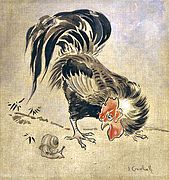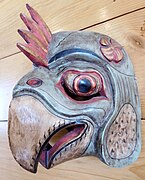Chicken
The chicken (Gallus gallus domesticus) is a large and round short-winged bird, domesticated from the red junglefowl of Southeast Asia around 8,000 years ago. Most chickens are raised for food, providing meat and eggs; others are kept as pets or for cockfighting.
| Chicken | |
|---|---|
 | |
| Male (left) and female chickens | |
Domesticated | |
| Scientific classification | |
| Domain: | Eukaryota |
| Kingdom: | Animalia |
| Phylum: | Chordata |
| Class: | Aves |
| Order: | Galliformes |
| Family: | Phasianidae |
| Genus: | Gallus |
| Species: | G. g. domesticus |
| Binomial name | |
| Gallus gallus domesticus | |
 | |
| Chicken distribution | |
| Synonyms | |
| Gallus domesticus L. | |
Chickens are common and widespread domestic animals, with a total population of 23.7 billion as of 2018[update], and an annual production of more than 50 billion birds. A hen bred for laying can produce over 300 eggs per year. There are numerous cultural references to chickens in folklore, religion, and literature.
Nomenclature
Terms for chickens include:
- Biddy: a chicken, or a newly hatched chicken
- Capon: a castrated or neutered male chicken
- Chick: a young chicken
- Chook /tʃʊk/: a chicken (Australia/New Zealand, informal)
- Cock: a fertile adult male chicken
- Cockerel: a young male chicken less than a year old
- Hen: an adult female chicken
- Pullet: a young female chicken less than a year old. In the poultry industry, a pullet is a sexually immature chicken less than 22 weeks of age.
- Rooster: a fertile adult male chicken, especially in North America. Originated in the 18th century as a euphemism to avoid the sexual connotation of the British English cock.
- Yardbird: a chicken (southern United States, dialectal)
Chicken may mean a chick (as in Hen and Chicken Islands). In older sources, and still often in trade and scientific contexts, chickens as a species are described as common fowl or domestic fowl.
Description
Chickens are relatively large birds, active by day. The body is round, the legs are unfeathered in most breeds, and the wings are short. Wild junglefowl can fly; chickens and their flight muscles are too heavy to allow them to fly more than a short distance. Size and coloration vary widely between breeds. Adult chickens of both sexes have a fleshy crest on their heads called a comb or cockscomb, and hanging flaps of skin on either side under their beaks called wattles; combs and wattles are more prominent in males. Some breeds have a mutation that causes extra feathering under the face, giving the appearance of a beard.
Chickens are omnivores. In the wild, they scratch at the soil to search for seeds, insects, and animals as large as lizards, small snakes, and young mice. A chicken may live for 5–10 years, depending on the breed. The world's oldest known chicken lived for 16 years.
Chickens are gregarious, living in flocks, and incubate eggs and raise young communally. Individual chickens dominate others, establishing a pecking order; dominant individuals take priority for access to food and nest sites. The concept of dominance, involving pecking, was described in female chickens by Thorleif Schjelderup-Ebbe in 1921 as the "pecking order". Male chickens tend to leap and use their claws in conflicts. Chickens are capable of mobbing and killing a weak or inexperienced predator, such as a young fox.
A male's crowing is a loud and sometimes shrill call, serving as a territorial signal to other males, and in response to sudden disturbances within their surroundings. Hens cluck loudly after laying an egg and to call their chicks. Chickens give different warning calls to indicate that a predator is approaching from the air or on the ground.
Reproduction and life-cycle
To initiate courting, some roosters may dance in a circle around or near a hen (a circle dance), often lowering the wing which is closest to the hen. The dance triggers a response in the hen and when she responds to his call, the rooster may mount the hen and proceed with the mating. Mating typically involves a sequence in which the male approaches the female and performs a waltzing display. If the female is unreceptive, she runs off; otherwise, she crouches, and the male mounts, treading with both feet on her back. After copulation the male does a tail-bending display.
Sperm transfer occurs by cloacal contact between the male and female, in an action called the 'cloacal kiss'. As with all birds, reproduction is controlled by a neuroendocrine system, the Gonadotropin-Releasing Hormone-I neurons in the hypothalamus. Reproductive hormones including estrogen, progesterone, and gonadotropins (luteinizing hormone and follicle-stimulating hormone) initiate and maintain sexual maturation changes. Reproduction declines with age, thought to be due to a decline in GnRH-I-N.

Hens often try to lay in nests that already contain eggs and sometimes move eggs from neighbouring nests into their own. A flock thus uses only a few preferred locations, rather than having a different nest for every bird. Under natural conditions, most birds lay only until a clutch is complete; they then incubate all the eggs. This is called "going broody". The hen sits on the nest, fluffing up or pecking defensively if disturbed. She rarely leaves the nest until the eggs have hatched.
Eggs of chickens from the high-altitude region of Tibet have special physiological adaptations that result in a higher hatching rate in low oxygen environments. When eggs are placed in a hypoxic environment, chicken embryos from these populations express much more hemoglobin than embryos from other chicken populations. This hemoglobin has a greater affinity for oxygen, binding oxygen more readily.
Fertile chicken eggs hatch at the end of the incubation period, about 21 days; the chick uses its egg tooth to break out of the shell. Hens remain on the nest for about two days after the first chick hatches; during this time the newly hatched chicks feed by absorbing the internal yolk sac. The hen guards her chicks and brood them to keep them warm. She leads them to food and water and calls them towards food. The chicks imprint on the hen and subsequently follow her continually. She continues to care for them until they are several weeks old.
Origin
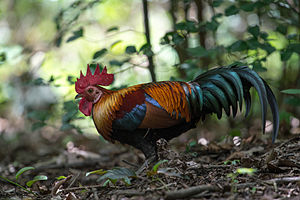
Water or ground-dwelling fowl similar to modern partridges, in the Galliformes, the order of bird that chickens belong to, survived the Cretaceous–Paleogene extinction event that killed all tree-dwelling birds and their dinosaur relatives. Chickens are descended primarily from the red junglefowl (Gallus gallus) and are scientifically classified as the same species. Domesticated chickens freely interbreed with populations of red junglefowl. The domestic chicken has subsequently hybridised with grey junglefowl, Sri Lankan junglefowl and green junglefowl; a gene for yellow skin, for instance, was incorporated into domestic birds from the grey junglefowl (G. sonneratii). It is estimated that chickens share between 71 and 79% of their genome with red junglefowl.
Domestication
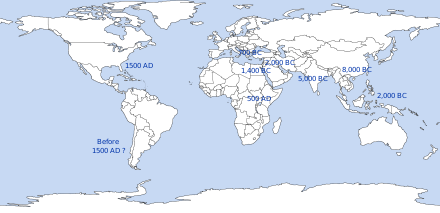
According to one early study, a single domestication event of the red junglefowl in present-day Thailand gave rise to the modern chicken with minor transitions separating the modern breeds. The red junglefowl is well adapted to take advantage of the vast quantities of seed produced during the end of the multi-decade bamboo seeding cycle, to boost its own reproduction. In domesticating the chicken, humans took advantage of the red junglefowl's ability to reproduce prolifically when exposed to a surge in its food supply.
Exactly when and where the chicken was domesticated remains controversial. Genomic studies estimate that the chicken was domesticated 8,000 years ago in Southeast Asia and spread to China and India 2,000 to 3,000 years later. Archaeological evidence supports domestic chickens in Southeast Asia well before 6000 BC, China by 6000 BC and India by 2000 BC. A landmark 2020 Nature study that fully sequenced 863 chickens across the world suggests that all domestic chickens originate from a single domestication event of red junglefowl whose present-day distribution is predominantly in southwestern China, northern Thailand and Myanmar. These domesticated chickens spread across Southeast and South Asia where they interbred with local wild species of junglefowl, forming genetically and geographically distinct groups. Analysis of the most popular commercial breed shows that the White Leghorn breed possesses a mosaic of divergent ancestries inherited from subspecies of red junglefowl.
Dispersal
Oceania

A word for the domestic chicken (*manuk) is part of the reconstructed Proto-Austronesian language, indicating they were domesticated by the Austronesian peoples since ancient times. Chickens, together with dogs and pigs, were carried throughout the entire range of the prehistoric Austronesian maritime migrations to Island Southeast Asia, Micronesia, Island Melanesia, Polynesia, and Madagascar, starting from at least 3000 BC from Taiwan. These chickens might have been introduced during pre-Columbian times to South America via Polynesian seafarers, but evidence for this is still putative.
Americas
The possibility that domestic chickens were in the Americas before Western contact is debated by researchers, but blue-egged chickens, found only in the Americas and Asia, suggest an Asian origin for early American chickens. A lack of data from Thailand, Russia, the Indian subcontinent, Southeast Asia and Sub-Saharan Africa makes it difficult to lay out a clear map of the spread of chickens in these areas; better description and genetic analysis of local breeds threatened by extinction may also help with research into this area. Chicken bones from the Arauco Peninsula in south-central Chile were radiocarbon dated as pre-Columbian, and DNA analysis suggested they were related to prehistoric populations in Polynesia. However, further study of the same bones cast doubt on the findings.
Eurasia
Chicken remains have been difficult to date, given the small and fragile bird bones; this may account for discrepancies in dates given by different sources. Archaeological evidence is supplemented by mentions in historical texts from the last few centuries BC, and by depictions in prehistoric artworks, such as across Central Asia. Chickens were widespread throughout southern Central Asia by the 4th century BC.
Middle Eastern chicken remains go back to a little earlier than 2000 BC in Syria. Phoenicians spread chickens along the Mediterranean coasts as far as Iberia. During the Hellenistic period (4th–2nd centuries BC), in the southern Levant, chickens began to be widely domesticated for food. The first pictures of chickens in Europe are found on Corinthian pottery of the 7th century BC.
Breeding increased under the Roman Empire and reduced in the Middle Ages. Genetic sequencing of chicken bones from archaeological sites in Europe revealed that in the High Middle Ages chickens became less aggressive and began to lay eggs earlier in the breeding season.
Africa
Chickens reached Egypt via the Middle East for purposes of cockfighting about 1400 BC and became widely bred in Egypt around 300 BC. Three possible routes of introduction into Africa around the early first millennium AD could have been through the Egyptian Nile Valley, the East Africa Roman-Greek or Indian trade, or from Carthage and the Berbers, across the Sahara. The earliest known remains are from Mali, Nubia, East Coast, and South Africa and date back to the middle of the first millennium AD.
Diseases

Chickens are susceptible both to parasites such as mites, and to diseases caused by pathogens such as bacteria and viruses. The parasite Dermanyssus gallinae feeds on blood, causing irritation and reducing egg production, and acts as a vector for bacterial diseases such as salmonellosis and spirochaetosis. Viral diseases include avian influenza.
Use by humans
Farming
Chickens are common and widespread domestic animals, with a total population of 23.7 billion as of 2018[update]. More than 50 billion chickens are reared annually as a source of meat and eggs. In the United States alone, more than 8 billion chickens are slaughtered each year for meat, and more than 300 million chickens are reared for egg production. The vast majority of poultry is raised in factory farms. According to the Worldwatch Institute, 74% of the world's poultry meat and 68% of eggs are produced this way. An alternative to intensive poultry farming is free-range farming. Friction between these two main methods has led to long-term issues of ethical consumerism. Opponents of intensive farming argue that it harms the environment, creates human health risks and is inhumane. Advocates of intensive farming say that their efficient systems save land and food resources owing to increased productivity, and that the animals are looked after in a controlled environment. Chickens farmed for meat are called broilers. Broiler breeds typically take less than six weeks to reach slaughter size, some weeks longer for free range and organic broilers.
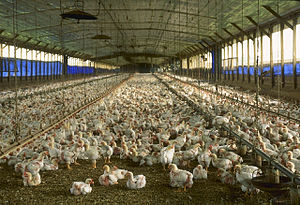
Chickens farmed primarily for eggs are called layer hens. The UK alone consumes more than 34 million eggs per day. Hens of some breeds can produce over 300 eggs per year; the highest authenticated rate of egg laying is 371 eggs in 364 days. After 12 months of laying, the commercial hen's egg-laying ability declines to the point where the flock is commercially unviable. Hens, particularly from battery cage systems, are sometimes infirm or have lost a significant amount of their feathers, and their life expectancy has been reduced from around seven years to less than two years. In the UK and Europe, laying hens are then slaughtered and used in processed foods, or sold as 'soup hens'. In some other countries, flocks are sometimes force moulted rather than being slaughtered to re-invigorate egg-laying. This involves complete withdrawal of food (and sometimes water) for 7–14 days or sufficiently long to cause a body weight loss of 25 to 35%, or up to 28 days under experimental conditions. This stimulates the hen to lose her feathers but also re-invigorates egg-production. Some flocks may be force-moulted several times. In 2003, more than 75% of all flocks were moulted in the US.
As pets
Keeping chickens as pets became increasingly popular in the 2000s among urban and suburban residents. Many people obtain chickens for their egg production but often name them and treat them as any other pet like cats or dogs. Chickens provide companionship and have individual personalities. While many do not cuddle much, they will eat from one's hand, jump onto one's lap, respond to and follow their handlers, as well as show affection. Chickens are social, inquisitive, intelligent birds, and many people find their behaviour entertaining. Certain breeds, such as silkies and many bantam varieties, are generally docile and are often recommended as good pets around children with disabilities.
Cockfighting

A cockfight is a contest held in a ring called a cockpit between two cocks. Cockfighting is outlawed in many countries as involving cruelty to animals. The activity seems to have been practised in the Indus Valley civilisation from 2500–2100 BC. In the process of domestication, chickens were apparently kept initially for cockfighting, and only later used for food.
In science
Chickens have long been used as model organisms to study developing embryos. Large numbers of embryos can be provided commercially; fertilized eggs can easily be opened and used to observe the developing embryo. Equally important, embryologists can carry out experiments on such embryos, close the egg again and study the effects later in development. For instance, many important discoveries in limb development have been made using chicken embryos, such as the discovery of the apical ectodermal ridge and the zone of polarizing activity.
The chicken was the first bird species to have its genome sequenced. At 1.21 Gb, the chicken genome is similarly sized compared to other birds, but smaller than nearly all mammals: the human genome is 3.2 Gb. The final gene set contained 26,640 genes (including noncoding genes and pseudogenes), with a total of 19,119 protein-coding genes, a similar number to the human genome. In 2006, scientists researching the ancestry of birds switched on a chicken recessive gene, talpid2, and found that the embryo jaws initiated formation of teeth, like those found in ancient bird fossils.
In culture, folklore, and religion
Chickens feature widely in folklore, religion, literature, and popular culture. The chicken is a sacred animal in many cultures and deeply embedded in belief systems and religious practices. Roosters are sometimes used for divination, a practice called alectryomancy. This involves the sacrifice of a sacred rooster, often during a ritual cockfight, used as a form of communication with the gods. In Gabriel García Márquez's Nobel-Prize-winning 1967 novel One Hundred Years Of Solitude, cockfighting is outlawed in the town of Macondo after the patriarch of the Buendia family murders his cockfighting rival and is haunted by the man's ghost. Chicken jokes have been made at least since The Knickerbocker published one in 1847. Chickens have featured in art in farmyard scenes such as Adriaen van Utrecht's 1646 Turkeys and Chickens and Walter Osborne's 1885 Feeding the Chickens. The nursery rhyme "Cock a doodle doo", its chorus line imitating the cockerel's call, was published in Mother Goose's Melody in 1765. The 2000 animated adventure comedy film Chicken Run, directed by Peter Lord and Nick Park, featured anthropomorphic chickens with many chicken jokes.
- Etruscan askos in the form of a rooster, 4th century B.C.
- Rooster and hen, Đông Hồ folk woodcut, Vietnam
- Feeding the chickens by Walter Osborne, 1885
- Joseph Crawhall III, Spanish Cock and Snail, c. 1900
- Wooden chicken mask, Bali, late 20th century
- Carved and painted wooden tribal statue of a cock fight, Yoruba, West Africa, c. 2000
Notes
References
External links

 Data related to Gallus gallus domesticus at Wikispecies
Data related to Gallus gallus domesticus at Wikispecies
This article uses material from the Wikipedia English article Chicken, which is released under the Creative Commons Attribution-ShareAlike 3.0 license ("CC BY-SA 3.0"); additional terms may apply (view authors). Content is available under CC BY-SA 4.0 unless otherwise noted. Images, videos and audio are available under their respective licenses.
®Wikipedia is a registered trademark of the Wiki Foundation, Inc. Wiki English (DUHOCTRUNGQUOC.VN) is an independent company and has no affiliation with Wiki Foundation.





